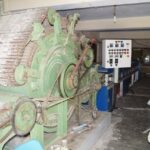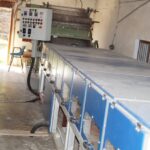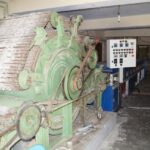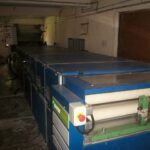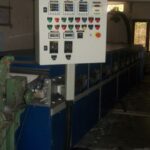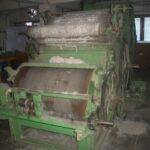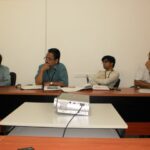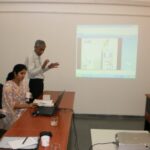DEVELOPMENT OF ATMOSPHERIC PRESSURE AIR PLASMA SYSTEM
DEVELOPMENT AND PERFORMANCE EVALUATION OF AN INDUSTRIAL SCALE ATMOSPHERIC PRESSURE AIR PLASMA SYSTEM TO TREAT ANGORA WOOL FOR MANUFACTURING OF 100% ANGORA PRODUCTS
INTRODUCTION AND BACKGROUND OF THE PROJECT
Angora fiber is widely considered to be one of the world’s most luxurious fibers, boasting exceptional warmth and smoothness that makes it eight times warmer than traditional sheep’s wool. However, due to its fibrosity and slipperiness, spinning it into yarn is a challenging process that can only be accomplished using hand-driven ‘takli’ spindles. Moreover, weaving 100% angora products is difficult, so manufacturers use Merino for the warp and angora for the weft. This limits productivity, increases fiber loss, and restricts the range of available products. Angora wool is primarily produced in the Himalayan region, and it is predominantly a female-driven village industry. The Institute for Plasma Research’s Facilitation Centre for Industrial Plasma Technologies (FCIPT) has successfully developed an innovative Atmospheric Pressure Air Plasma Technology with financial support from the Department of Science & Technology (DST), Government of India, to enhance the surface modification of angora wool. Plasma treatment of the fibers now enables both hand-spinning and mill spinning of the yarn, followed by hand-weaving the fabric. The most attractive feature of the Atmospheric Pressure Plasma System is its continuous mode of operation, which eliminates the need for special plasmagen gas. Additionally, the plasma processing cost and system maintenance cost are considerably lower than other plasma techniques. The technology is also eco-friendly, making it an ideal candidate for commercial application at the industrial level.
AIMS AND OBJECTIVES OF THE PROJECT
1. Develop an industrial-scale atmospheric pressure air plasma treatment system designed to modify the surface properties of 1-meter-wide angora web, achieving processing speeds of 3-4 meters per minute.
2. Optimize angora wool processing efficiency through the application of the plasma treatment system, resulting in heightened productivity and decreased fiber loss.
3. Customize the plasma treatment system to cater to the specific requirements and characteristics of angora wool processing.
4. Establish the plasma treatment system within the premises of the HIFEED Campus, enabling the assessment of its performance and facilitating the production of 100% angora products from the treated fibers.
5. Manufacture premium-quality angora products that meet market demand, contributing to increased revenue generation for the local communities involved.
6. Offer consistent and ongoing plasma treatment services for angora wool to rural communities actively engaged in the development of angora-based products.
7. Provide widespread access to advanced technology and specialized expertise to ensure the production of top-tier angora products capable of meeting the standards of both local and global markets.
8. Act as a catalyst for the expansion of the angora wool industry, thereby fostering growth and improvement in the livelihoods of the local communities involved.
COMPONENTS AND ACTIVITIES OF THE PROJECT
1. Initiate the creation and optimization of plasma through systematic processes, while concurrently designing and developing a plasma system.
2. Formulate specifications for plasma generation and secure necessary resources for assembling and testing the plant.
3. Offer practical demonstrations and comprehensive training sessions on plasma processes, ensuring proficiency in handling the technology.
4. Execute the seamless installation and integration of the plasma system with the carding machine, followed by meticulous evaluation of the system’s performance.
5. Propagate the technique widely and extend valuable service offerings to farmers engaged in angora wool production.
6. Conduct illustrative demonstrations of the technology, showcasing its benefits to encourage wider adoption.
7. Innovate and establish an efficient plasma treatment system meticulously tailored for angora wool processing, thereby fostering sustainable growth within the local angora wool industry.
TARGET AREA OF THE PROJECT
The designated focus area of the project was the Common Facility Centre (CFC) situated within the HIFEED Campus in Ranichauri. It was within this location that the plasma plant was installed and where the majority of the project’s activities were executed.
TARGET GROUPS AND BENEFICIARIES OF THE PROJECT
The principal recipients of the project’s benefits were the families engaged in the production of angora rabbit wool. These families played a central role in producing high-quality angora wool within the state of Uttarakhand.
FUNDING PARTNER OF THE PROJECT
The Department of Science & Technology (DST), Ministry of Science & Technology, Government of India, New Delhi provided the funding for the project. The project was implemented by HIFEED, in technical collaboration with the Institute for Plasma Research, Department of Atomic Energy, Government of India, Gandhi Nagar, Gujarat.
SANCTIONED BUDGET OF THE PROJECT
The Department of Science & Technology (DST) sanctioned the project in the year 2010 with the sanction order No. DST/TSG/TC/2009/22/2 dated 01.10.2010. The total budget of the project, sanctioned by DST for two years, was Rs. 44,66,000.00.
OUTCOMES AND ACHIEVEMENTS OF THE PROJECT
The successful installation of Atmospheric Pressure Air Plasma Systemhas resulted in the following outcomes and achievements:
1. A plasma treatment system has been set up at the HIFEED Campus to evaluate its performance and manufacture 100% angora products from treated fibers. This has enabled the production of high-quality angora products that meet market demand and generate revenue for local communities.
2. The plasma system has been installed and integrated with the carding machine, and its performance has been evaluated.
3. Routine plasma treatment services for angora wool have been provided to the people of rural areas involved in angora wool product development. By providing these services, the project has supported the growth of the angora wool industry and improved the livelihoods of local communities.
4. Plasma generation and process optimization, the design and development of a plasma system, and the generation and procurement of specifications have been completed.
5. Overall, the project has accomplished its objectives by developing an effective and efficient plasma treatment system for angora wool processing and promoting the growth and sustainability of the local angora wool industry.


